I am no longer teaching NRA firearms classes, though I did that for more than 25 years, mostly giving classes for folks wanting to get their concealed handgun permit. During all those years teaching handgun classes, I had quite a few students ask me about buying used handguns.
What To Look For When Buying Used Handguns
They wanted to know what to look for. More often than not, I’d accompany them to the local gun shop and help them in selecting a used handgun and talk with them about what to look for in a good used handgun.
I’m a sucker for a good deal on a used handgun. I don’t have the funds to buy new firearms all the time, so when I see a used handgun that catches my eye I give it a very close inspection, most of the time.
Overall Condition, Rust or Patina, Pitted Metal
One of the first things I look at is the overall condition of the gun. If it has pitted metal, I know it hasn’t been properly cared for. I can live with a little surface rust or patina, but deep pits in the metal, well, that’s a “no-go” for me.
Personally Inspect Firearms To Make Sure They Are Not Loaded
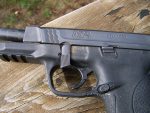 Please keep in mind that you should personally inspect any firearms you are about to handle in a gun shop or a gun show to make sure they are not loaded. While I’ve never run across a loaded firearm in a gun shop, I have run across them at gun shows.
Please keep in mind that you should personally inspect any firearms you are about to handle in a gun shop or a gun show to make sure they are not loaded. While I’ve never run across a loaded firearm in a gun shop, I have run across them at gun shows.
To wit, one time at a gun show in Denver, Colorado– a huge show with over a thousand tables– my partner and I heard a gun shot in the hall next to us. I ran over to see what happened.
A fellow had picked up a .22 LR handgun off a seller’s table, as I’ve seen thousands of times, without checking to see if it was loaded, put the barrel of the gun into the palm of his hand, and pulled the trigger. Well, this time, the gun was loaded. The bullet passed through the palm of his hand, hit another guy in the upper arm, ricocheted off the floor, and was sticking in the calf muscle of a teenaged boy. You could have pulled the bullet out of his calf, as it wasn’t in very far. However, this young man just assumed that if you got shot you would die. Luckily, it all turned out fine, but this young man did go into shock just as the paramedics arrived. So, please check any firearms you pick up, and don’t assume they aren’t loaded.
Are Screws “Buggered Up”?
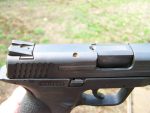 Take a good look at the screws on any handgun. See if they are in good shape, or if they have been buggered up by someone removing screws without a good set of gunsmith screw drivers. They can really mess up the screws. On a revolver, that more than likely means that they removed the side plate, and who knows what they did on the inside of that revolver?
Take a good look at the screws on any handgun. See if they are in good shape, or if they have been buggered up by someone removing screws without a good set of gunsmith screw drivers. They can really mess up the screws. On a revolver, that more than likely means that they removed the side plate, and who knows what they did on the inside of that revolver?
Muzzle End
I check the muzzle end of any handguns I’m considering buying. If they are all rough, that means that the gun may not shoot very accurately.
Revolver Trigger Pull
On a revolver, I’ll check the single action and double action trigger pull. If it is too light, that means someone tinkered with it. I also pull the trigger and hold it, and try to see how much “play” is in the cylinder. If it moves too much, the cylinder could be out of alignment, which is not good, or the “hand” is worn out. I visually look and see about the gap between the cylinder and the barrel’s forcing cone. If the gap looks overly large, the gun might need work before you can safely fire it. I also check to make sure that the cylinder is locked tight when closed. There should be no wiggle room there.
Semi-Auto Play
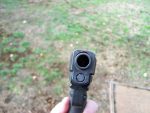 When it comes to semi-auto handguns, I check some other things. Of course, I check to see how much “play” is between the slide/frame/barrel. This is really important on a good ol’ 1911. If the gun rattles when you shake it, odds are that the accuracy isn’t going to be what you expect.
When it comes to semi-auto handguns, I check some other things. Of course, I check to see how much “play” is between the slide/frame/barrel. This is really important on a good ol’ 1911. If the gun rattles when you shake it, odds are that the accuracy isn’t going to be what you expect.
Semi-Auto Barrel
I also press down on the barrel’s hood. If it goes down a little too much, the barrel might need to be replaced, or a new barrel link pin is in order.
Trigger Pull on Semi-Auto
It’s a very good idea to also check the trigger pull on the semi-auto handgun too. Once again, if it is too light, someone might have tinkered with it, and you don’t want the gun going off accidentally. I check for hammer follow. I’ll rack the slide and pull the trigger, and while holding the trigger reward, I’ll rack the slide again, and if the hammer follows the slide down, you need some serious work done on the gun for it to be safe to shoot.
Barrel
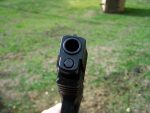 I often check the condition of the barrel on the inside, to see if there are plenty of lands and grooves. Not very often I’ve run across a handgun that had a “shot out” barrel. On a 1911, I’ll also look at the step between the frame’s ramp and the bottom of the barrel. There should be a very small “step” of distance between the feed ramp and the barrel. This is important for proper feeding. Sometimes, a wannabe gunsmith will grind away on the frame until in matches the barrel feed ramp, but that’s not how a 1911 was designed to work. In this case, you will most likely have to replace the frame, which is very expensive.
I often check the condition of the barrel on the inside, to see if there are plenty of lands and grooves. Not very often I’ve run across a handgun that had a “shot out” barrel. On a 1911, I’ll also look at the step between the frame’s ramp and the bottom of the barrel. There should be a very small “step” of distance between the feed ramp and the barrel. This is important for proper feeding. Sometimes, a wannabe gunsmith will grind away on the frame until in matches the barrel feed ramp, but that’s not how a 1911 was designed to work. In this case, you will most likely have to replace the frame, which is very expensive.
A Gun Not Safe To Shoot
On a recent outing to my local gun shop, Fast Cash in Lebanon, OR, I spied a used S&W M&P full-sized 45ACP. It was dirty and had some light surface rust that looked easy enough to clean up to make the gun look brand new. However, on this outing, I didn’t have my reading glasses, and I didn’t examine the gun as closely as I normally would have. The extractor had a lot of rust under it, and the rear sight was rusted. Still, those things could be cleaned up. It wasn’t until after I took the gun home and was about to give it a really good cleaning that I noticed the end of the slide, where the barrel protrudes, was cracked. I’m talking a serious crack.
I never saw this before on any semi-auto handgun. I completely missed this at the gun shop without my reading glasses on. The owners of the shop didn’t catch this either, when they took it in on trade. See the close-up pic, and you’ll notice the cracked slide, as well as in some other pics, how rusted the gun was. In any event, this gun was not safe to shoot.
Fast Cash has a very good operation. If you purchase a firearm from them and it doesn’t work, whether new or used, they will do their best to make it right. In this case they offered to return the gun to S&W for me or give me a store credit. I elected to take the credit and walked out with a different gun. They did send that M&P back to S&W and a new slide was installed.
Store Policy
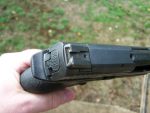 Ask the folks behind the gun counter if they have any kind of policy on used guns. Most new guns will be repaired free of charge by the maker. If a gun shop isn’t willing to stand behind the used guns they sell, then I’d look elsewhere for a used gun.
Ask the folks behind the gun counter if they have any kind of policy on used guns. Most new guns will be repaired free of charge by the maker. If a gun shop isn’t willing to stand behind the used guns they sell, then I’d look elsewhere for a used gun.
At my local gun shop, I’ve repaired more than a few used guns they took in trade over the years. Quite often, very often, it only took a good cleaning and lube to make the gun work again.
Take a Friend or Family
It’s difficult to outline all the things you should check when considering the purchase of a used handgun and you’re not confident enough to know what you’re looking for. I suggest then you take a friend or family member along, who can help you point out the good and bad points on a particular handgun. If something doesn’t look right or feel right, when you handle a handgun, then odds are it might need some professional attention, which can cost you a lot of money. Many gunsmiths are charging $35-$50 per hour for their labor, and, of course, parts are extra.
Finish Wear Doesn’t Affect Function
I’ve never been overly concerned with “holster wear” on the finishes on handguns. It is a natural occurring thing. However, some folks are really bothered by some of the finish that has been worn off. Today, many handguns, especially semi-auto handguns, have some super-tough finishes on them. So, it’s very rare to see that finish worn off on a semi-auto’s slide. Finish wear doesn’t affect the function of a handgun.
Don’t be afraid to purchase used firearms. There are some outstanding deals to be hand, so shop around.

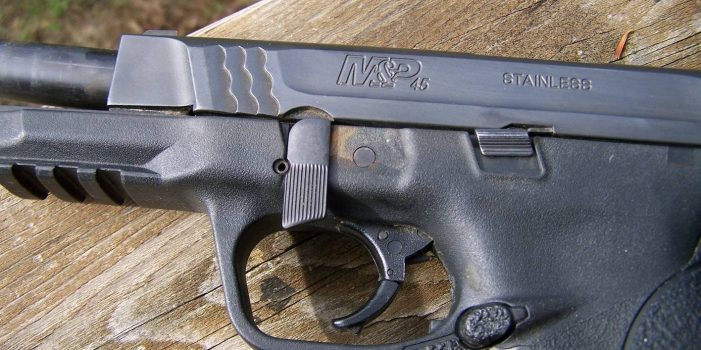









This is very helpful. Thanks.
Finally, Pat shows an M&P .45……. and it’s all buggered up!
My son and I were looking at a used Ruger Security Six on a private seller’s table at a gun show. I opened the cylinder and found one .38 SPL cartridge still in the cylinder, even though the hammer was strapped with a wire tie per show rules. The seller was surprised, and told us he had loaded the revolver the night before at his hotel for a nightstand gun, thought he had unloaded it in the morning. This can easily happen on a revolver if the unfired rounds are dumped out without using the ejector rod. One chamber may be a little tighter and hold the round in, or the round may hit the frame and bounce back in rather than fall out. I’ve seen this happen on my own revolvers a couple times. As Pat says, always check and recheck to be certain the firearm is unloaded!
I have always been hesitant to buy a used gun. Thanks Pat for great advice on what to look for.
Buying a used gun is like buying a used car, you never know for sure what that gun has been through! If you know the person that you are buying it from, and how they treat their firearms, then you should be OK! Always assume that a firearm is loaded and point it in a safe direction! Never point a gun at anyone unless you plan on shooting them!!!!!!!!
I have a couple of Q-tips on me, when I go to gun shows. Any time I consider a gun purchase, new or used, I pull a Q-tip, and wipe around near the trigger or chamber to see if there’s carbon or too much grease on it. I never buy a dirty gun, or one with too much grease on it. Every barrel gets closely inspected, and having my phone with me allows me to check on what people have said about the model.
I have recently purchased a used Kimber Micro nine, according to the seals and inspection tags, the said firearm was made and shipped in April of 17. It doesn’t appear to have been fired very much , but that being said, it will be headed to the local gun shop for a check up ( hopefully I won’t be getting loving out of it, like I did with a bersa .380 )
I bought a Taurus 66, .357 Magnum 7-shot revolver, used at a gun shop run by a friend. The lock-up was bad, the slots in the cylinder were too wide and uneven. Knowing it had a lifetime warrany, I had the gun shop send it back to Taurus. It took some time, but eventually they called and asked the proprietor/gunsmith why it was back. He explained the poor lock-up, and they fixed it. It’s like a custom fitted gun now (I guess it is) and was a wonderful inexpensive acquisition. It’s my “bear country” hiking gun now, 7 rounds of 200 gr. hard cast lead bullets.
I had a good friend that was a gun dealer. He was selling an estate collection for a lady he knew…Many nice guns were in that collection as well as a box of pistols that had been stored in the garage. Well, the rats had a party in the drawer they were stored in. Needless to say they were less than pristine!
I have a fondness for old S&W’s, and a couple of early 5 screws in 38spl caught my eye. Not only were the rusted, but they were quite pitted, sticky, and smelled bad!!! The inside of the barrel and cylinders were perfect, so I took a chance, and picked them up for $100 a piece…Seems pricey for rust buckets, but the grips were worth half that.
Long story short… After clean up, the internals were perfect. All the nasty was external. A quick re-blue and I now have 2 fully functional Smiths. Yea, the are still pitted but they work as though new.
I use them as loaners and trainers, and lovingly refer to them as my RAT PIStols… Worth a hundred…Yea, cause beauty is only skin deep, it’s what’s inside that counts!
Used rifles(semi and bolt) next? Then shotguns?
At gun shows, and gun shops, I have a jeweler’s eye loupe in my pocket, an LED headlamp and a 2.5 gallon ziplock plastic bag, specifically for use on used guns. If the gun passes intial inspection and I’m still interested, I’ll hand-hold the headlamp and take a very close look at the key places I’ve seen wear or damage on that type of firearm. If it passes that, and I’m still interested, I’ll tell the seller I’m seriously interested and request permission to field strip the gun (if the seller wants to do the field stripping, that’s OK with me, as long as I get my hands on all the parts to check fit between parts individually). Sometimes spring pressure from recoil springs will hide a fitment issue with the barrel/slide interface, and removing the slide allows closer inspection of the innards, which is where the eye loupe and headlamp come in. I put the gun in the plastic bag to contain springs because I want to see fitment both unpsrung and under spring tension.
You’ll find one of three things: a gun in good enough condition to be worth the purchase price, one in poor enough condition to not be worth it, or one is good but needs some form of repair or parts replacement, which offers an opportunity to bargain with the seller.